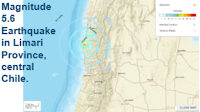Authorities in Chile have opened an investigation after a giant sinkhole opened up close to a copper mine in Copiapó Province, Chile, on Saturday 30 July 2022. Sernageomin, the body responsible for mine safety in Chile, ordered all activities to cease at the mine pending the outcome of the investigation, after it was made aware of the situation at the Alcaparossa Mine on Sunday 31 July. The mine's owners, the Canadian mining giant Lundin Mining, have issued a statement to the effect that no workers have been harmed by the event, but has otherwise declined to comment at this time. The sinkhole is described as being 25 m across, at least 600 m across, and flooded at the bottom.
While the vast majority of sinkholes are natural in origin, the mining industry clearly has the capacity to bring about conditions leading to sinkholes, and sinkholes at mining, or former mining, sites are a problem around the world. The most obvious way in which a mine can cause a sinkhole is by direct undermining; over-enthusiastic removal of material without leaving enough in place to support the overlying rocks will eventually lead to a collapse, and often a sinkhole at the surface. However, sinkholes often occur in places close to mines but where the mine does not pass directly underneath. This is usually as a result of the mine providing a conduit through which water enters susceptible strata, leading to erosion and sinkhole formation away from the mining activity.
See also...
Follow Sciency Thoughts on Facebook.
Follow Sciency Thoughts on Twitter.







